wheel size PORSCHE 911 CARRERA 2006 5.G Owners Manual
[x] Cancel search | Manufacturer: PORSCHE, Model Year: 2006, Model line: 911 CARRERA, Model: PORSCHE 911 CARRERA 2006 5.GPages: 308, PDF Size: 3.69 MB
Page 65 of 308
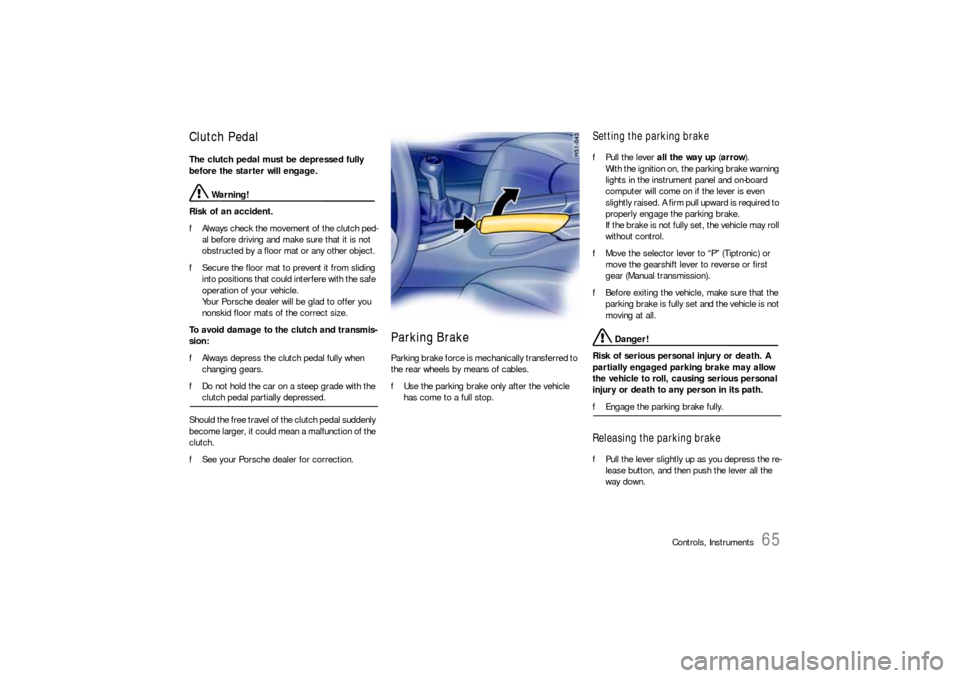
Controls, Instruments
65
Clutch Pedal The clutch pedal must be depressed fully
before the starter will engage.
Warning!
Risk of an accident.
fAlways check the movement of the clutch ped-
al before driving and make sure that it is not
obstructed by a floor mat or any other object.
fSecure the floor mat to prevent it from sliding
into positions that could interfere with the safe
operation of your vehicle.
Your Porsche dealer will be glad to offer you
nonskid floor mats of the correct size.
To avoid damage to the clutch and transmis-
sion:
fAlways depress the clutch pedal fully when
changing gears.
fDo not hold the car on a steep grade with the clutch pedal partially depressed.
Should the free travel of the clutch pedal suddenly
become larger, it could mean a malfunction of the
clutch.
fSee your Porsche dealer for correction.
Parking Brake Parking brake force is mechanically transferred to
the rear wheels by means of cables.
fUse the parking brake only after the vehicle
has come to a full stop.
Setting the parking brake fPull the lever all the way up (arrow).
With the ignition on, the parking brake warning
lights in the instrument panel and on-board
computer will come on if the lever is even
slightly raised. A firm pull upward is required to
properly engage the parking brake.
If the brake is not fully set, the vehicle may roll
without control.
fMove the selector lever to “P” (Tiptronic) or
move the gearshift lever to reverse or first
gear (Manual transmission).
fBefore exiting the vehicle, make sure that the
parking brake is fully set and the vehicle is not
moving at all.
Danger!
Risk of serious personal injury or death. A
partially engaged parking brake may allow
the vehicle to roll, causing serious personal
injury or death to any person in its path.
fEngage the parking brake fully.Releasing the parking brakefPull the lever slightly up as you depress the re-
lease button, and then push the lever all the
way down.
Page 70 of 308
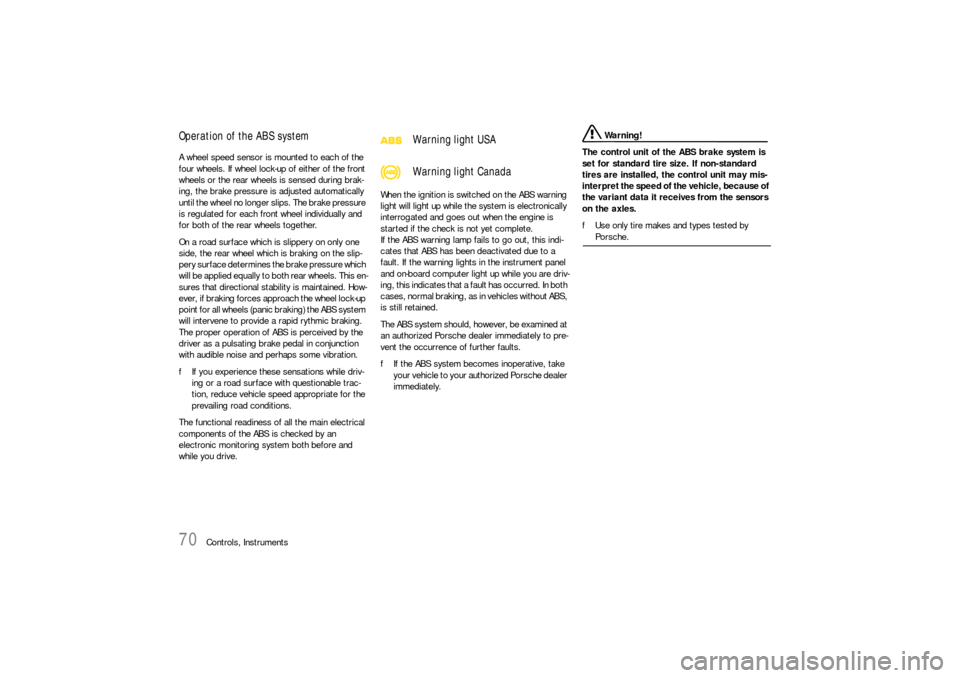
70
Controls, Instruments
Operation of the ABS systemA wheel speed sensor is mounted to each of the
four wheels. If wheel lock-up of either of the front
wheels or the rear wheels is sensed during brak-
ing, the brake pressure is adjusted automatically
until the wheel no longer slips. The brake pressure
is regulated for each front wheel individually and
for both of the rear wheels together.
On a road surface which is slippery on only one
side, the rear wheel which is braking on the slip-
pery surface determines the brake pressure which
will be applied equally to both rear wheels. This en-
sures that directional stability is maintained. How-
ever, if braking forces approach the wheel lock-up
point for all wheels (panic braking) the ABS system
will intervene to provide a rapid rythmic braking.
The proper operation of ABS is perceived by the
driver as a pulsating brake pedal in conjunction
with audible noise and perhaps some vibration.
fIf you experience these sensations while driv-
ing or a road surface with questionable trac-
tion, reduce vehicle speed appropriate for the
prevailing road conditions.
The functional readiness of all the main electrical
components of the ABS is checked by an
electronic monitoring system both before and
while you drive. When the ignition is switched on the ABS warning
light will light up while the system is electronically
interrogated and goes out when the engine is
started if the check is not yet complete.
If the ABS warning lamp fails to go out, this indi-
cates that ABS has been deactivated due to a
fault. If the warning lights in the instrument panel
and on-board computer light up while you are driv-
ing, this indicates that a fault has occurred. In both
cases, normal braking, as in vehicles without ABS,
is still retained.
The ABS system should, however, be examined at
an authorized Porsche dealer immediately to pre-
vent the occurrence of further faults.
fIf the ABS system becomes inoperative, take
your vehicle to your authorized Porsche dealer
immediately.
Warning!
The control unit of the ABS brake system is
set for standard tire size. If non-standard
tires are installed, the control unit may mis-
interpret the speed of the vehicle, because of
the variant data it receives from the sensors
on the axles.
fUse only tire makes and types tested by Porsche.
Warning light USA
Warning light Canada
Page 109 of 308

Controls, Instruments
109
TPC
Tire pressure monitoringPlease observe the chapter “TIRE PRESSURES” on
Page 232.
The tire pressure monitoring continuously
monitors tire pressure and tire temperature on all
four wheels and warns the driver when the tire
pressure is too low.
The display as well as the settings for the tire
pressure monitoring take place on the on-board
computer.
However, you must still adjust the tire pressure on
the wheel.
fThe driver is responsible for filling the tires
correctly and making the correct settings on
the on-board computer.
The tire pressure monitoring offers the following
functions:
– Display of the actual tire pressure while the
vehicle is in motion
– Display of the deviation from the required
pressure (refilling pressure)
– Display of currently set tire size and type
– Tire pressure warnings in two stages
Safety notes!
Despite the advantages offered by the tire
pressure monitoring, it is still the driver’s
responsibility to update the corresponding
settings in the on-board computer and
maintain the pressure in the tires. Low tire
pressure reduces the road safety of the
vehicle and destroys the tire and wheel.
fWhen a flat tire has been displayed, immedi-
ately stop in a suitable place and check the
tires for damage. If necessary, remedy the
damage with a tire sealant.
fDo not by any means continue to drive with
damaged tires.
fSealing the tire with tire sealant is only an
emergency repair, so you can drive to the next
authorized Porsche dealer. The maximum per-
mitted speed is 50 mph (80 km/h).
fDo not drive with tires whose tire pressure
drops again in a short period of time. In cases
of doubt, have tires checked by an authorized
Porsche dealer.
fDamaged tires must be immediately replaced
by an authorized Porsche dealer.
Tire repairs are not permissible under any
circumstances.fIf the tire pressure monitoring is defective (e.g.
defective wheel transmitter), contact an
authorized Porsche dealer immediately and
have the damage repaired.
The tire pressure will not be monitored by a
defective tire pressure monitoring.
fTires lose air over time without a tire defect
being present. A tire pressure warning will then
appear in the on-board computer display.
Correct the tire pressure at the next oppor-
tunity.
fThe tire pressure monitoring gives a warning
about tire damage due to natural pressure loss
as well as about a gradual loss of pressure due
to foreign objects.
The tire pressure monitoring cannot warn you
about tire damage that occurs suddenly (e.g.
flat tire due to abrupt external effects).
Page 112 of 308
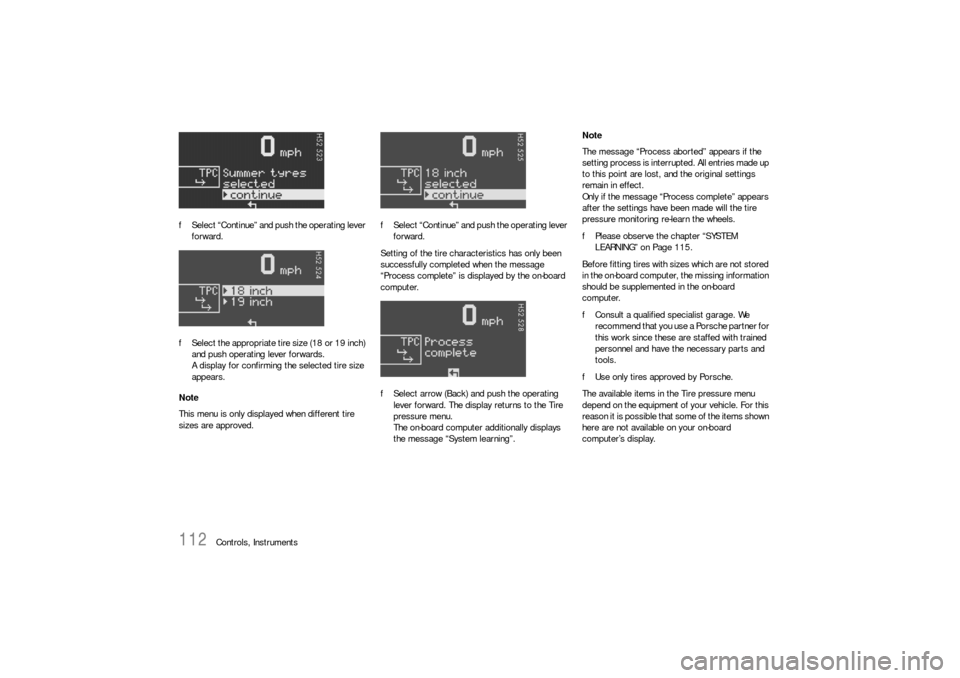
112
Controls, Instruments fSelect “Continue” and push the operating lever
forward.
fSelect the appropriate tire size (18 or 19 inch)
and push operating lever forwards.
A display for confirming the selected tire size
appears.
Note
This menu is only displayed when different tire
sizes are approved.fSelect “Continue” and push the operating lever
forward.
Setting of the tire characteristics has only been
successfully completed when the message
“Process complete” is displayed by the on-board
computer.
fSelect arrow (Back) and push the operating
lever forward. The display returns to the Tire
pressure menu.
The on-board computer additionally displays
the message “System learning”.Note
The message “Process aborted” appears if the
setting process is interrupted. All entries made up
to this point are lost, and the original settings
remain in effect.
Only if the message “Process complete” appears
after the settings have been made will the tire
pressure monitoring re-learn the wheels.
fPlease observe the chapter “SYSTEM
LEARNING” on Page 115.
Before fitting tires with sizes which are not stored
in the on-board computer, the missing information
should be supplemented in the on-board
computer.
fConsult a qualified specialist garage. We
recommend that you use a Porsche partner for
this work since these are staffed with trained
personnel and have the necessary parts and
tools.
fUse only tires approved by Porsche.
The available items in the Tire pressure menu
depend on the equipment of your vehicle. For this
reason it is possible that some of the items shown
here are not available on your on-board
computer’s display.
Page 233 of 308
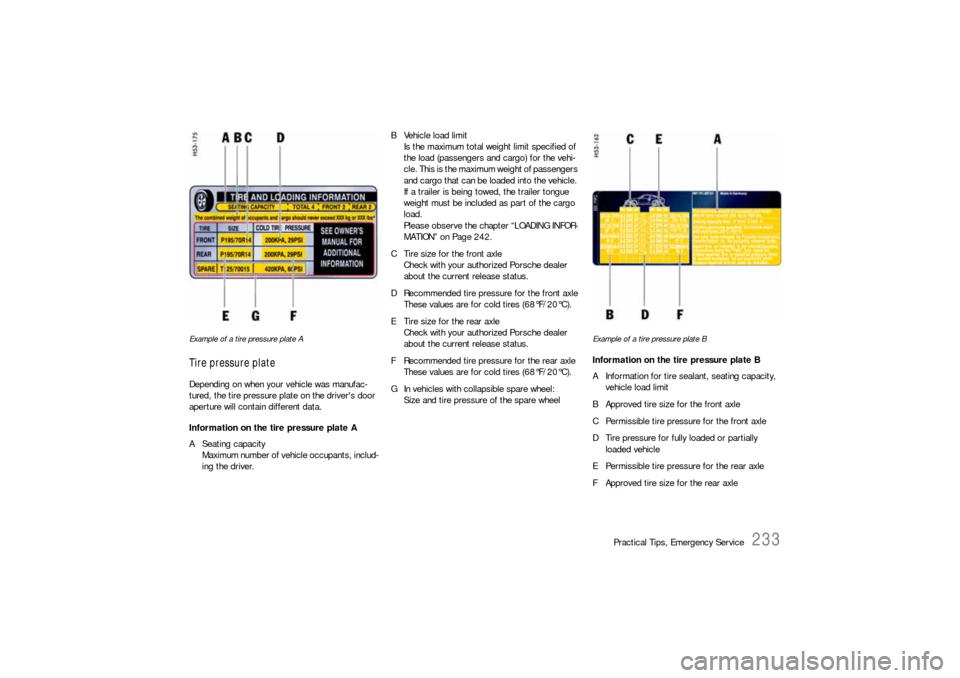
Practical Tips, Emergency Service
233
Example of a tire pressure plate ATire pressure plateDepending on when your vehicle was manufac-
tured, the tire pressure plate on the driver's door
aperture will contain different data.
Information on the tire pressure plate A
A Seating capacity
Maximum number of vehicle occupants, includ-
ing the driver.B Vehicle load limit
Is the maximum total weight limit specified of
the load (passengers and cargo) for the vehi-
cle. This is the maximum weight of passengers
and cargo that can be loaded into the vehicle.
If a trailer is being towed, the trailer tongue
weight must be included as part of the cargo
load.
Please observe the chapter “LOADING INFOR-
MATION” on Page 242.
C Tire size for the front axle
Check with your authorized Porsche dealer
about the current release status.
D Recommended tire pressure for the front axle
These values are for cold tires (68°F/20°C).
E Tire size for the rear axle
Check with your authorized Porsche dealer
about the current release status.
F Recommended tire pressure for the rear axle
These values are for cold tires (68°F/20°C).
G In vehicles with collapsible spare wheel:
Size and tire pressure of the spare wheel
Example of a tire pressure plate BInformation on the tire pressure plate B
A Information for tire sealant, seating capacity,
vehicle load limit
B Approved tire size for the front axle
C Permissible tire pressure for the front axle
D Tire pressure for fully loaded or partially
loaded vehicle
E Permissible tire pressure for the rear axle
F Approved tire size for the rear axle
Page 249 of 308

Practical Tips, Emergency Service
249
SpacersfUse the spacers only together with wheels and
fastening parts approved by Porsche.
Before having spacers fitted, find out about the
current approval status.911 Carrera 4, 911 Carrera 4S
Danger!
Risk of accident.
17 mm spacers must only be mounted on the
rear axle together with 11.5 J x 19 (67 mm
rim offset) wheels.
fAlways remove 17 mm spacers before
mounting other wheel sizes or an emergency
spare wheel because the wheel cannot be mounted correctly.
911 Carrera, 911 Carrera SMounting an emergency spare wheel
If 5 mm spacers are mounted, these must not be
removed to mount an emergency spare wheel.
Fitting snow chains
The use of snow chains is not permitted when
5 mm spacers are mounted.
Caution!
Risk of damage to the wheel housings if the
5 mm spacers are not removed before fitting
snow chains.
fTo permit the fitting of snow chains, have the 5 mm spacers removed on all 4 wheels.Note on operation
fTo fit/remove the spacers:
Please consult an authorized Porsche dealer.
fPlease observe the chapter “17 MM
SPACERS” on Page 252.
Please observe the chapter “5 MM SPACERS”
on Page 253.
Page 252 of 308
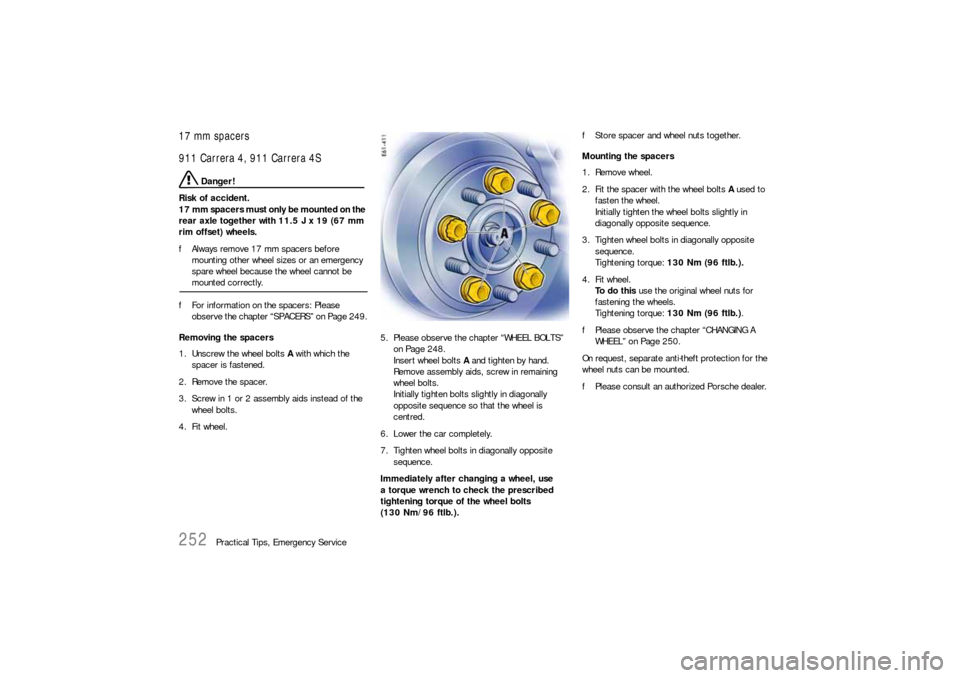
252
Practical Tips, Emergency Service
17 mm spacers
911 Carrera 4, 911 Carrera 4S
Danger!
Risk of accident.
17 mm spacers must only be mounted on the
rear axle together with 11.5 J x 19 (67 mm
rim offset) wheels.
fAlways remove 17 mm spacers before
mounting other wheel sizes or an emergency
spare wheel because the wheel cannot be mounted correctly.
fFor information on the spacers: Please
observe the chapter “SPACERS” on Page 249.
Removing the spacers
1. Unscrew the wheel bolts A with which the
spacer is fastened.
2. Remove the spacer.
3. Screw in 1 or 2 assembly aids instead of the
wheel bolts.
4. Fit wheel. 5. Please observe the chapter “WHEEL BOLTS”
on Page 248.
Insert wheel bolts A and tighten by hand.
Remove assembly aids, screw in remaining
wheel bolts.
Initially tighten bolts slightly in diagonally
opposite sequence so that the wheel is
centred.
6. Lower the car completely.
7. Tighten wheel bolts in diagonally opposite
sequence.
Immediately after changing a wheel, use
a torque wrench to check the prescribed
tightening torque of the wheel bolts
(130 Nm/96 ftlb.).fStore spacer and wheel nuts together.
Mounting the spacers
1. Remove wheel.
2. Fit the spacer with the wheel bolts A used to
fasten the wheel.
Initially tighten the wheel bolts slightly in
diagonally opposite sequence.
3. Tighten wheel bolts in diagonally opposite
sequence.
Tightening torque: 130 Nm (96 ftlb.).
4. Fit wheel.
To d o t h i s use the original wheel nuts for
fastening the wheels.
Tightening torque: 130 Nm (96 ftlb.).
fPlease observe the chapter “CHANGING A
WHEEL” on Page 250.
On request, separate anti-theft protection for the
wheel nuts can be mounted.
fPlease consult an authorized Porsche dealer.
Page 288 of 308

288
Technical Data
Tires, Rims, Tracks 911 Carrera, 911 Carrera S
Tire Rim Rim offset Track
Summer tires*front 235/40 ZR 18 (91Y) 8 J x 18 H2 57 mm 58.5 in./1486 mm
rear 265/40 ZR 18 (101Y) XL 10 J x 18 H2 58 mm 60.4 in./1534 mm
orfront 235/35 ZR 19 (87Y) 8 J x 19 H2 57 mm 58.5 in./1486 mm
rear 295/30 ZR 19 (100Y) XL 11 J x 19 H2 67 mm 59.7 in./1516 mm
orfront 235/35 ZR 19 (87Y) 8.5 J x 19 H2 55 mm 58.7 in./1490 mm
rear 305/30 ZR 19 (102Y) XL 11.5 J x 19 H2 67 mm 59.7 in./1516 mm
Snow tiresfront 235/40 R 18 91V M+S 8 J x 18 H2 57 mm 58.5 in./1486 mm
rear 265/40 R 18 97V M+S** 10 J x 18 H2 58 mm 60.4 in./1534 mm
orfront 235/35 R 19 87V M+S 8 J x 19 H2 57 mm 58.5 in./1486 mm
rear 295/30 R 19 100V XL M+S 11 J x 19 H2 67 mm 59.7 in./1516 mm
The load capacity coefficient (e.g. “91”) and maximum speed code letter (e.g. “Y”) are minimum requirements.
Snow chainsCan be mounted only on the rear wheels; maximum speed 30 mph (50 km/h).
Use only Porsche authorized fine-link cross-type or edge chains.
Snow chain clearance can be guaranteed only on the tire + rim combination marked** without spacers.
Tire and rim sizesExtensive tests are performed before specific tires and wheels are approved by Porsche. Your Porsche dealer has informa-
tion about approved tires and wheels and is happy to assist you.
If aftermarket tires and/or wheels are installed which are not approved by Porsche, the vehicle’s roadability and handling
characteristics might be impaired. Since Porsche has no data on such combinations, Porsche cannot stand behind the safe-
ty or durability of these aftermarket combinations.
* 911 Carrera S: Summer tires 19-inch only
Page 289 of 308

Technical Data
289
Tires, Rims, Tracks 911 Carrera 4, 911 Carrera 4S
Tire Rim Rim offset Track
Summer tires* front 235/40 ZR 18 (91Y) 8 J x 18 H2 57 mm 58.6 in./1488 mm
rear 295/35 ZR 18 (99Y) 11 J x 18 H2 51 mm 60.9 in./1548 mm
or front 235/35 ZR 19 (87Y) 8 J x 19 H2 57 mm 58.6 in./1488 mm
rear 305/30 ZR 19 (102Y) XL 11 J x 19 H2 51 mm 60.9 in./1548 mm
or front 235/35 ZR 19 (87Y) 8.5 J x 19 H2 55 mm 58.7 in./1492 mm
rear 305/30 ZR 19 (102Y) XL 11.5 J x 19 H2** 67 mm 61.0 in./1550 mm
Snow tires front 235/40 R 18 91V M+S 8 J x 18 H2 57 mm 58.6 in./1488 mm
rear 295/35 R 18 99V M+S*** 11 J x 18 H2 51 mm 60.9 in./1548 mm
or front 235/35 R 19 87V M+S 8 J x 19 H2 57 mm 58.6 in./1488 mm
rear 295/30 R 19 100V XL M+S*** 11 J x 19 H2 51 mm 60.9 in./1548 mm
The load capacity coefficient (e.g. “91”) and maximum speed code letter (e.g. “Y”) are minimum requirements.
Snow chains Can be mounted only on the rear wheels; maximum speed 30 mph (50 km/h).
Use only Porsche authorized fine-l ink cross-type or edge chains.
Snow chain clearance can be guaranteed on ly on the tire + rim combination marked***.
Tire and rim sizes Extensive tests are performed before specific tires and wheels are approved by Porsche. Your Porsche dealer has information
about approved tires and wheels and is happy to assist you.
If aftermarket tires and/or wheels are in stalled which are not approved by Porsche, the vehicle’s roadability and handling cha-
racteristics might be impaired. Since Porsche has no data on such combinations, Porsche cannot stand behind the safety or
durability of these af termarket combinations.
* 911 Carrera 4S: Summer tires 19-inch only ** Only approved together with 17 mm spacers
Page 290 of 308

290
Technical Data
Tire Pressures for cold tiresSummer and snow tires 911 Carrera, 911 Carrera S
Summer and snow tires 911 Carrera 4, 911 Carrera 4S
These tire filling pressures apply only to the tire makes and types approved by Porsche.
Please observe the chapter “TIRES/WHEELS” on Page 229. Please observe the chapter “TPC TIRE PRESSURE MONITORING” on Page 109.
Danger!
Installation of sizes not authorized by
Porsche may have a dangerous effect on
the driving stability and could result in
severe personal injury or death.
fBefore mounting new tires, check with your Porsche dealer about the current release status.
18 inch wheels front 36 psi (2.5 bar)
rear 44 psi (3.0 bar)
19 inch wheels, partially loaded front 33 psi (2.3 bar)
(up to 2 persons without luggage) rear 39 psi (2.7 bar)
19 inch wheels, fully loaded front 36 psi (2.5 bar)
(as of 2 persons with luggage) rear 44 psi (3.0 bar)
18 inch and 19 inch wheels, partially loaded front 33 psi (2.3 bar)
(up to 2 persons without luggage) rear 39 psi (2.7 bar)
18 inch and 19 inch wheels, fully loaded front 36 psi (2.5 bar)
(as of 2 persons with luggage) rear 44 psi (3.0 bar)